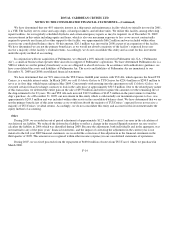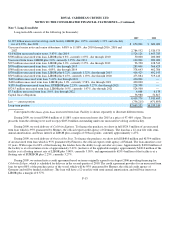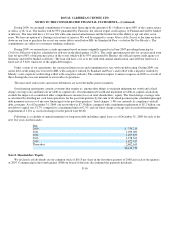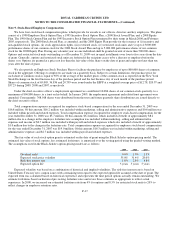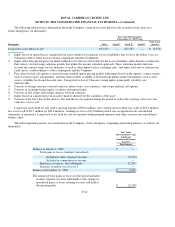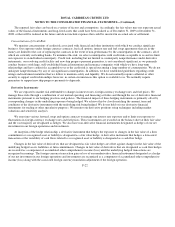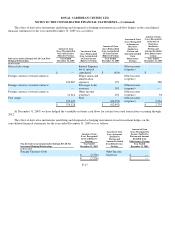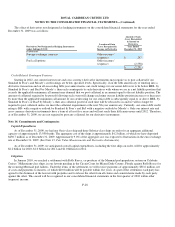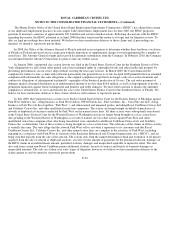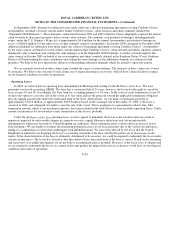Royal Caribbean Cruise Lines 2009 Annual Report Download - page 96
Download and view the complete annual report
Please find page 96 of the 2009 Royal Caribbean Cruise Lines annual report below. You can navigate through the pages in the report by either clicking on the pages listed below, or by using the keyword search tool below to find specific information within the annual report.
ROYAL CARIBBEAN CRUISES LTD.
NOTES TO THE CONSOLIDATED FINANCIAL STATEMENTS—(Continued)
On an ongoing basis, we assess whether derivatives used in hedging transactions are “highly effective” in offsetting changes in
the fair value or cash flow of hedged items. We use the long-haul method to assess hedge effectiveness using regression analysis for
each hedge relationship under our interest rate, foreign currency and fuel hedging programs. We apply the same methodology on a
consistent basis for assessing hedge effectiveness to all hedges within each hedging program (i.e. interest rate, foreign currency and
fuel). We generally perform regression analysis over an observation period commensurate with the contractual life of the derivative
instrument up to three years. High effectiveness is achieved when a statistically valid relationship reflects a high degree of offset and
correlation between the fair values of the derivative instrument and the hedged item. The determination of ineffectiveness is based on
the amount of dollar offset between the change in fair value of the derivative instrument and the change in fair value of the hedged
item at the end of the reporting period. If it is determined that a derivative is not highly effective as a hedge or hedge accounting is
discontinued, any change in fair value of the derivative since the last date at which it was determined to be effective is recognized in
earnings. In addition, the ineffective portion of our highly effective hedges is recognized in earnings immediately and reported in
other income (expense) in our consolidated statements of operations.
Cash flows from derivative instruments that are designated as fair value or cash flow hedges are classified in the same category
as the cash flows from the underlying hedged items. In the event that hedge accounting is discontinued, cash flows subsequent to the
date of discontinuance are classified consistent with the nature of the instrument.
Interest Rate Risk
Our exposure to market risk for changes in interest rates relates to our long-term debt obligations including future interest
payments. At December 31, 2009, approximately 43% of our long-term debt was effectively fixed and approximately 57% was
floating. We enter into interest rate and cross currency swap agreements to modify our exposure to interest rate movements and to
manage our interest expense. We assess the risk that changes in interest rates will have either on the fair value of debt obligations or
on the amount of future interest payments by monitoring changes in interest rate exposures and by evaluating hedging opportunities.
Market risk associated with our long-term fixed rate debt is the potential increase in fair value resulting from a decrease in
interest rates. We enter into interest rate swap agreements that effectively convert a portion of our fixed-rate debt to a floating-rate
basis to manage this risk. At December 31, 2009 our interest rate swap agreements effectively changed $350.0 million of debt with a
fixed rate of 7.25% to LIBOR-based floating rate debt, and €€1.0 billion of debt with a fixed rate of 5.625% to EURIBOR-based
floating rate. In addition, at December 31, 2009 we had cross currency swap agreements that effectively changed €€300.0 million of
the €€1.0 billion floating EURIBOR-based debt to $389.1 million of floating LIBOR-based debt.
Our interest rate swaps and cross currency swap agreements are accounted for as fair value hedges. During the year ended
December 31, 2009, we recognized in earnings, a net loss of approximately $9.4 million which represented the total ineffectiveness of
the fair value hedges pertaining to interest rate and cross currency swaps. This amount includes an out of period adjustment of
approximately $7.1 million which represents the cumulative reduction in the fair value of certain interest rate swaps during 2007 and
2008 due to an error in data embedded in the software we use to assist with calculating the fair value of our interest rate swaps.
Because the adjustment, both individually and in the aggregate, was not material to any of the prior years’ financial statements, and
the impact of correcting the adjustment in the current year is not material to the full year 2009 financial statements, we recorded the
correction of this adjustment in the financial statements in the first quarter of 2009.
The notional amount of outstanding debt related to interest rate swaps as of December 31, 2009 was $1.8 billion. The notional
amount of outstanding debt related to cross currency swaps as of December 31, 2009 was $389.1 million.
F-23



